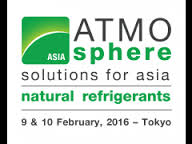Natural refrigeration systems on the rise
ASIA – The latest edition of ATMOsphere Asia has shown that natural refrigerant systems are proliferating in Asian countries, offering environmentally friendly solutions while helping to reduce operating costs in a wide range of areas, from cold storage or ice rinks to ground freezing for construction work.
Ardi Wijaya from PT Adib Global Food Supplies revealed that the Indonesian cold storage company is on a journey to green its process chain. Forecasting growth in the refrigeration market amid increased customer demand in the coming years, the company decided to invest in refrigeration for its cold storage warehouse and processing facility.
To choose the right system, PT Adib Global Food Supplies took into account several factors: it had to be energy efficient, safe and durable. It also had to have an appropriate support system and to comply with the latest regulations, which, according to Wijaya, are “pushing the industry towards natural refrigerants”.
The company decided to use Japanese manufacturer Mayekawa’s CO2/NH3 NewTon system, and installed a NewTon R-6000 in a cold storage facility and a NewTon F-300 in a quick freezer. With these systems, PT Adib Global Food Supplies expects to considerably reduce its greenhouse gas emissions – by 120 tons of CO2 per year in its cold storage and 21 tons of CO2 per year in its quick freezer.
Wijaya argues that in addition to being environmentally sustainable, using natural refrigerants improves the company’s image and is also beneficial from a financial point of view. The company’s installations consume at least 25-30% less power than a R22 system in similar-sized storage facilities.
Although the operating costs of the CO2/NH3 system are lower, Wijava stresses that the biggest challenge to overcome is the relatively high initial investment cost. “It is more expensive compared to a traditional ammonia system or Freon,” he said, suggesting that funds and special financing schemes from the government or an international organisation could help to solve this problem.
Emiko Ilda from Japanese ice rink company Patine Leisure raised similar concerns. While Japan has 190 old ice skating systems in need of upgrading, according to Ilda, the initial cost of a new natural refrigerant system is higher than the cost of installing a conventional systems. Ilda highlighted the importance of developing more affordable technologies and called for a more flexible financial support system.
The Japanese government offers subsidies for retrofitting old systems, “but the timeframe required to complete the projects is much shorter” than realistically feasible, according to Ilda. “Typically, the government requires companies to complete a project within a fiscal year, while ice skating projects take at least 2-3 years,” she argued.
Nevertheless, “it is obvious that the NH3/CO2 rink system is the direction to go,” said Ilda, expressing hope that these systems will have a bright future in Asia, where energy bills represent 25% of operating costs. “If we can reduce energy consumption, there is very big potential in Asia,” she said.
Ilda’s presentation showed that Patine Leisure’s CO2/NH3 ice rink systems reduce power consumption by over 40%, compared to conventional ice skating rinks using an R22 glycole system.
“The total power consumption per square metre of ice surface is reduced tremendously. The chiller system represents 70-80% of the power consumption, so it’s obvious that the new system gives us great savings,” she concluded.
The company’s flagship installation in Salitama, Japan has a 10-year payback period, with solar power offsetting aproximately 90% of energy consumption.
As part of its corporate sustainability initiative, Japan-based Yokorei also chose to use a CO2/NH3 refrigeration system, and installed Mayekawa’s NewTon R-3000 units for its Yumeshime Logistics Centre in light of the initial, operating and 20-year lifecycle costs.
The cold storage facility has seen a 38% reduction in power consumption compared to a similar-sized logistics centre, while the company has also implemented solar panels and LED lighting in a number of its 43 facilities.
CO2/NH3 systems can also be used for ground freezing in construction work, as explained by Hiroshi Soma, who manages the engineering development department at Japan-based Chemical Grouting. His presentation compared a CO2/NH3 freezing system to a conventional R22 system, which achieved a vastly greater coefficient of performance of 2.55 compared to 1.63.
Test results show that the CO2/NH3 system reduces power consumption by 60% compared to a conventional R22 system. Chemical Grouting intends to help green the construction sector in Japan, with a metropolitan expressway and bullet train among projects planned works in the near future.















